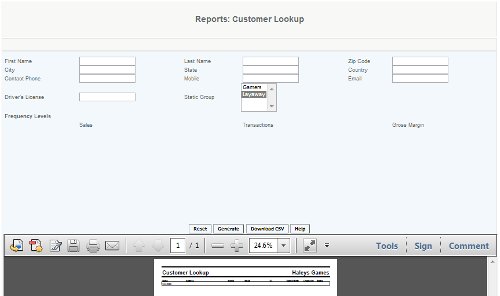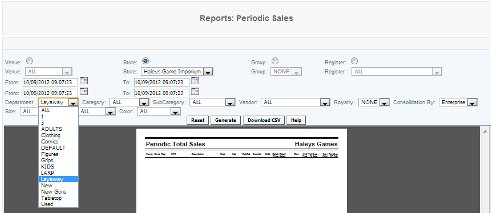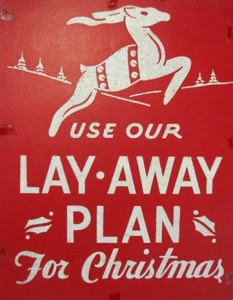Prepaid Deposit Transactions (Layaway)
Overview:
Layaway, which lets shoppers pay for items in installments, can seem like a good option for shoppers who want to stick to a budget. In-store layaway — in which a store sets aside an item that a shopper wants to buy and lets them pay for it in installments before they can take it home — may seem old-fashioned in a world where most people have credit cards, but it's aimed at consumers who don't have the cash for big purchases or don't want to run up their credit card bills.
Terms vary by retailer, but often programs will only allow shoppers to put certain items — or items above a certain price point — on layaway. Shoppers will also be expected to make regular payments on these goods, and most stores ask for a down payment. Missing a payment, deciding you don't want an item, or failing to pick it up on time will likely result in a cancellation fee ranging from $10 to $15, though shoppers should get the rest of their payments back in cash or store credit.
Reasons Retailers have for adding a layaway option for their customers:
- Increase traffic into the store: Layaway programs will mean that shoppers will be walking into the store monthly or bi-weekly to make the required payments. These increased visits to the store, means more opportunities for the sales associates to recommend or engage shoppers while they are in front of them and could lead to more purchases by the consumer. #MSIB
- There is a high probability that existing customers are likely to know shoppers that prefer to buy through layaway programs, and share the layaway program with them. Layaway offers opportunities to sell items, to those shoppers that otherwise may have not purchased products from a retailer because they need to spread their payments over time. This allows new opportunities for new customers, increased sales and growing your CRM. #bringmorecustomerstoyourstore
- Layaway is an ideal marketing opportunity for retailers to get shoppers to start their Christmas shopping. They are able to purchase the products they want, without having to hunt for them later. It also alleviates the high credit card debts that shoppers experience at the end of the holiday season, giving consideration to no regrets and to keep shopping at the beginning of the year #makingtheholidayshappier
- Layaway should not be considered just as a Christmas or Holiday arrangement; neighborhood stores should utilize layaway as an opportunity to market products during slow periods through their layaway program. #relevantmarketing
- Retailers can utilize data from the reports based on their customized options. #retailmadesimple
- Retailers are able to set their rules and payment based on their business practices and can easily track their payments to ensure what payments are due. #retailmadesimple
- Layaway payments don’t only need to be paid with cash; merchants can opt to accept them through paypal and dwolla, engaging mobile shoppers #mPOS
- Gen Y- establishing the new financial norms, are advised to ask store associates if they offer a layaway plan. Could layaway be the new norm for Gen Y?
Set Up:
The prepaid (or layaway) program must be defined. This is done on CAS (Management>Transaction Codes>Prepaid) by the System Administrator or Financial Roles.
CAS - Prepaid (Layaway) Set up
Initial Prepaid Transaction (on POS):
When a customer wants to create a prepaid transaction, this is done from the Sales Transaction Screen (with the customer attached to the transaction)
POS - Prepaid Sale (Initial Transaction)
All Future Prepaid Payments (on POS):
When a customer wants to make payments (or the final payment) on the Prepaid (Layaway) items, this is done from the POS>Transaction>Prepaid screen.
CAS Report - Prepaid Activity Report:
The Prepaid Activity report will give the user basic information on all of the prepaid transactions. Use the filter criteria to hone into areas of interest.
Note
Please note that enabling STS will allow the user to access STS for more specific payment and balance information
Previous Process: (Prior to May 2013)
Using Gift Cards (Purchase through STS)
The layaway process includes the use of gift cards to track real time payments and balances. We will set up this through STS (merchant will have a small monthly fee and will need to purchase gift cards)
Processing the layaway:
Customer has an item they want to purchase through layaway and will make initial down payment.
Merchant sells a gift card for the amount of the down payment.
Add Customer name to sale, put in the comment section of the Sales Transaction screen any layaway information. All future payments are additions to the gift card.
Merchant accesses the STS web site for balances on each card.
Once customer has made last payment, make a sale for the merchandise using gift card for payment.
ALTERNATE PROCESS WITHOUT GIFT CARDS
CAS:
Create "Layaway" service item (does not affect inventory), set department to "Layaway" to help look up the layaway activity in reports.
Create a static customer category called "Layaway"
POS:
Add customer to database (Customer should be added to the Customer category Layaway). Add layaway sale info to customer record for reference (start date, items on layaway, and total sale price of layaway)
To determine total sales amount, cashier can run a sale for the item that will be on layaway (see the total including tax, etc) then void/do not complete the sale – use this for obtaining total sales amount only.
Customer wants to make down payment, Cashier sells the service item "layaway" (on the sales transaction add customer and put layaway information in the comment section such as start date, item description, total sale amount).
Once customer has made last payment, make a sale for the merchandise using cash. Refund the layaway item for the amount of the sale. This will reduce the Layaway service item by the full sale amount and a sale for the merchandise will be made for the actual inventory item (both cash transactions balance each other out).
Reports:
Customer – pull by static group "layaway"
Periodic Sales – Pull by Department "layaway"




